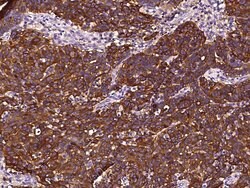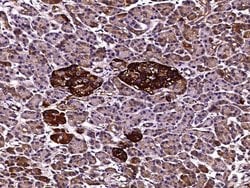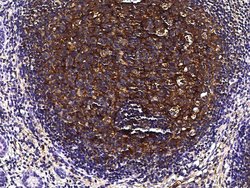Learn More
Invitrogen™ Apolipoprotein J Recombinant Rabbit Monoclonal Antibody (210)
Rabbit Recombinant Monoclonal Antibody
Supplier: Invitrogen™ MA529163
Description
This product is preservative free. It is recommended to add sodium azide to avoid contamination (final concentration 0.05%-0.1%). Recombinant rabbit monoclonal antibodies are produced using in vitro expression systems. The expression systems are developed by cloning in the specific antibody DNA sequences from immunoreactive rabbits. Then, individual clones are screened to select the best candidates for production. The advantages of using recombinant rabbit monoclonal antibodies include: better specificity and sensitivity, lot-to-lot consistency, animal origin-free formulations, and broader immunoreactivity to diverse targets due to larger rabbit immune repertoire. This antibody has specificity for Human Clusterin/Apolipoprotein J/Apo-J/CLU.
Isoform 1 functions as extracellular chaperone that prevents aggregation of nonnative proteins. Prevents stress-induced aggregation of blood plasma proteins. Inhibits formation of amyloid fibrils by APP, APOC2, B2M, CALCA, CSN3, SNCA and aggregation-prone LYZ variants (in vitro). Does not require ATP. Maintains partially unfolded proteins in a state appropriate for subsequent refolding by other chaperones, such as HSPA8/HSC70. Does not refold proteins by itself. Binding to cell surface receptors triggers internalization of the chaperone-client complex and subsequent lysosomal or proteasomal degradation. Secreted isoform 1 protects cells against apoptosis and against cytolysis by complement. Intracellular isoforms interact with ubiquitin and SCF (SKP1-CUL1-F-box protein) E3 ubiquitin-protein ligase complexes and promote the ubiquitination and subsequent proteasomal degradation of target proteins. Promotes proteasomal degradation of COMMD1 and IKBKB. Modulates NF-kappa-B transcriptional activity. Nuclear isoforms promote apoptosis. Mitochondrial isoforms suppress BAX-dependent release of cytochrome c into the cytoplasm and inhibit apoptosis. Plays a role in the regulation of cell proliferation.
Specifications
| Apolipoprotein J | |
| Recombinant Monoclonal | |
| 1 mg/mL | |
| PBS with no preservative | |
| P10909 | |
| Clu | |
| Recombinant Human Clusterin/Apolipoprotein J/Apo-J/CLU protein. | |
| 100 μL | |
| Primary | |
| Human | |
| Antibody | |
| IgG |
| Immunohistochemistry (Paraffin) | |
| 210 | |
| Unconjugated | |
| Clu | |
| AAG4; Aging associated protein 4; Aging-associated gene 4 protein; aging-associated protein 4; AI893575; apo j; Apo J a; Apo J alpha; Apo J b; Apo J beta; Apo J a; Apo J ß; Apo Ja; Apo Jb; ApoJ; Apo-J; ApoJ a; ApoJ alpha; ApoJ b; ApoJ beta; ApoJ a; ApoJ ß; ApoJa; ApoJalpha; ApoJb; ApoJbeta; Apolipoprotein J; CLI; Clu; CLU1; CLU2; clusterin; Clusterin alpha / beta chain; Clusterin alpha chain; Clusterin beta chain; Clustrin; Complement associated protein SP40; complement cytolysis inhibitor; Complement cytolysis inhibitor a chain; Complement cytolysis inhibitor b chain; complement lysis inhibitor; complement-associated protein SP-40,40; D14Ucla3; DAG; Dimeric acid glycoprotein; GP80; HGNC:2095; ku70-binding protein 1; Ku70-binding protein 1 (KUB1); KUB1; MGC24903; Msgp-2; NA1/NA2; RATTRPM2B; SGP2; Sgp-2; SP40; SP-40; Sugp-2; sulfated glycoprotein 2; Sulfated glycoprotein 2 (SGP2); testosterone repressed prostate message; testosterone repressed prostate message 2; Testosterone repressed prostate message 2 (TPRM2B); testosterone repressed prostate message-2; testosterone-repressed prostate message; testosterone-repressed prostate message 2; testostrone-repressed prostate message 2; Trpm2; TRPM-2; TRPM2B; Trpmb | |
| Rabbit | |
| Protein A | |
| RUO | |
| 1191 | |
| Store at 4°C short term. For long term storage, store at -20°C, avoiding freeze/thaw cycles. | |
| Liquid |
Your input is important to us. Please complete this form to provide feedback related to the content on this product.


